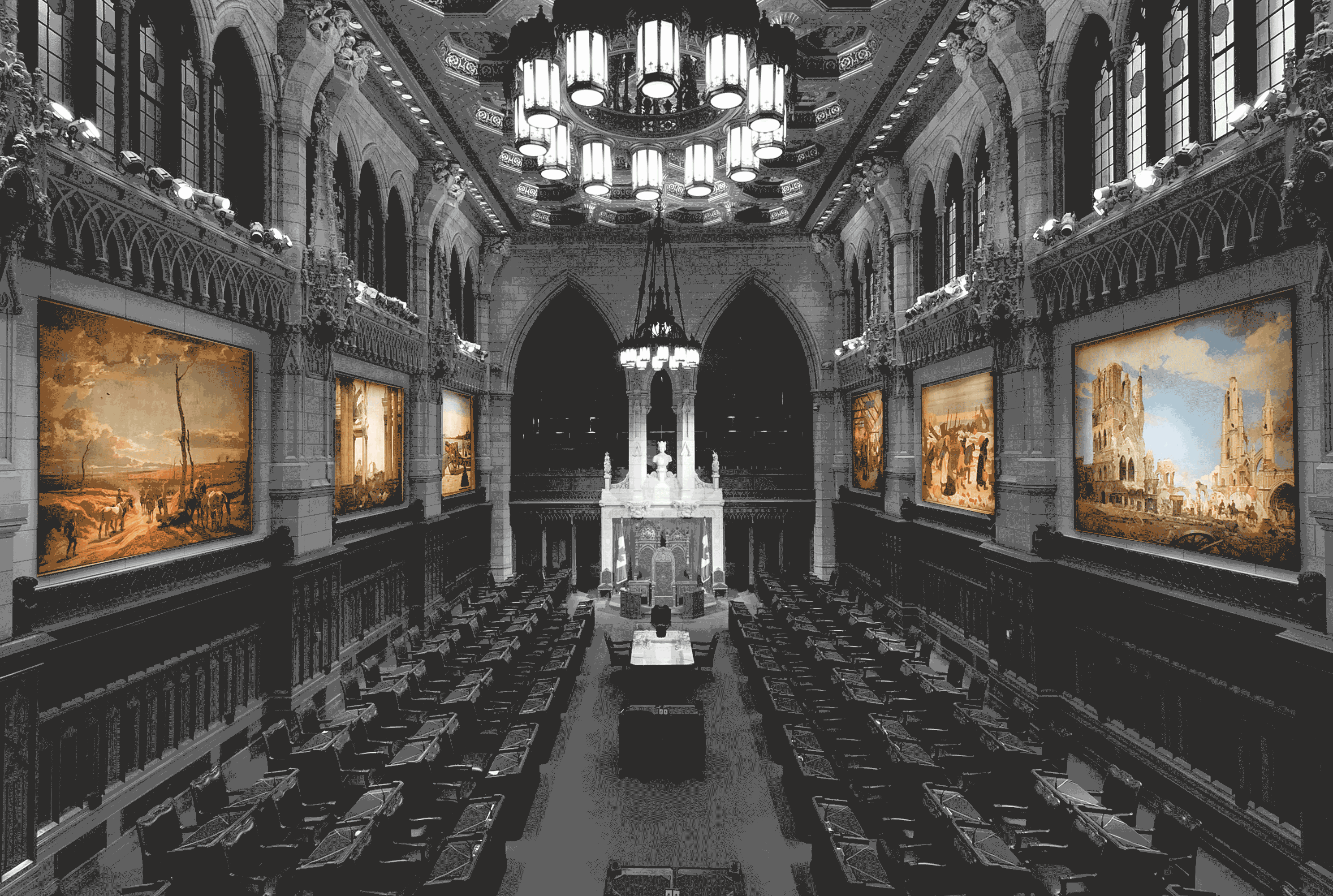Engaging Students in the (Senate) Chamber of Secrets

© W. Lloyd MacKenzie, via Flickr @ http://www.flickr.com/photos/saffron_blaze/
Students easily recognize The Parliament of Canada as an iconic part of Canada’s political history. Seated among the grand and exquisite Gothic revival architecture of Parliament Hill, it is home to the legislative process that we often see on CPAC. Yet there is much more history there than meets the eye!
As politicians debate, applaud, and shout out in favour of one party or another, the large, beautiful paintings on the inner walls of the building tell stories of significant aspects of our early history in the First World War and how it contributed to the unification of a greater Canada. Each painting invites the public to reflect on the valiant efforts of citizens a century ago. Taking students to this famous Centre Block, as you can on an Explorica Ottawa tour, allows you to intertwine informative and reflective discussions on both the Canadian political process and Canada’s involvement in the First World War.
1. Landing of the First Canadian Division at Saint-Nazaire, 1915
Painted in 1916 by Edgar Bundy (1862-1922)

© Canadian War Museum
The title of the work refers to their arrival in the French port of Saint-Nazaire in February 1915. The Division consisted of 18,500 men, many of whom were very young recruits. On the waterfront, the pipe band of The Black Watch (Royal Highlanders of Canada), led by Pipe-Major David Manson, plays the troops ashore. The steamship Novian, which transported the troops from England, is seen in the background. To the right, officers, troops and townspeople watch the arrival. (Source)
2. A Mobile Veterinary Unit in France
Painted in 1917 by Algernon Talmage (1871-1939)

© Canadian War Museum
Talmage’s painting depicts a scene near the Cambrai front in France. A Canadian Mobile Veterinary Unit is shown taking wounded horses from the front line of battle back to an evacuating station. The mobile veterinary units were part of the Canadian Veterinary Services and worked in the field to collect and give first aid to wounded, sick or overworked animals before transporting them by train to base hospitals. (Source)
3. Railway Construction in France
Painted in 1917 by Leonard Richmond (1878-1965)

© Canadian War Museum
The painting by the British artist Leonard Richmond depicts the construction of a railway built in the deepest trench in France by the Canadian Overseas Railway Construction Corps. Railway construction and repair during the First World War frequently took place under difficult conditions, often near front lines. While the location of this scene was some distance behind the front, the soft soil of the area created many engineering problems. (Source)
4. Arras, the Dead City
Painted in 1919 by James Kerr-Lawson (1865-1939)

© Canadian War Museum
In 1917, the Canadian War Memorials Fund commissioned Major James Kerr-Lawson to journey to the battlefields of France and Belgium to paint two large canvases of the ruins of Arras and Ypres. These two historic cities had suffered greatly in the shelling. In Arras, The Dead City, the ruins of Arras Cathedral are shown as they were in 1917. (Source)
5. On Leave
Painted in 1918 by Claire Atwood (1866-1962)

© Canadian War Museum
In 1917, the Canadian War Memorials Fund commissioned the British painter, Clare Atwood, to execute a large picture depicting the life of the Canadian Expeditionary Force in England. Appropriateness of subject matter for women artists was still a consideration during the 1914-1918 conflict, and they were not commissioned to depict the battlefield. Portraits and scenes of home front activity were assigned to female artists. Nevertheless, Atwood, who had gained recognition for her interior scenes, was chosen for the commission. (Source)
6. The Cloth Hall, Ypres
Painted circa 1919 by James Kerr-Lawson (1865-1939)

© Canadian War Museum
Before its destruction in the First World War, the Cloth Hall in the Belgian city of Ypres was among the surviving marvels of medieval architecture in northern Europe. Originally built by the wealthy Flemish cloth guilds, the Hall was a splendid example of Gothic civic architecture. (Source)
7. The Watch on the Rhine (The Last Phase)
Painted in 1920 by Sir William Rothenstein (1872-1945)

© Canadian War Museum
The painting was originally exhibited in Canada in 1920 as part of the Canadian War Memorials exhibition. The painting’s many symbolic elements represent the defeat of Germany and the triumph of the Allied Forces. In the foreground, a British howitzer faces out across the Rhine River. The painting’s powerful imagery is reinforced by the prominence given by the artist to the enormous gun. A British sentry stands on guard to one side. The 1920 exhibition catalogue notes that, behind the sentry, old and new Germany are represented by ancient hills and the new factory chimney. (Source)
8. Returning to the Reconquered Land
Painted in 1919 by Sir George Clausen (1852-1944)

© Canadian War Museum
In 1918, the Canadian War Memorials Fund commissioned the British artist George Clausen to paint a large canvas focusing on the subject of agriculture behind the lines in France. Clausen was a well-known landscape, figure and portrait painter. (Source)
You can learn about Explorica’s Keating tours to Ottawa online.

